Practice Corner MCQs
Quiz Summary
0 of 104 Questions completed
Questions:
Information
You have already completed the quiz before. Hence you can not start it again.
Quiz is loading…
You must sign in or sign up to start the quiz.
You must first complete the following:
Results
Results
0 of 104 Questions answered correctly
Your time:
Time has elapsed
You have reached 0 of 0 point(s), (0)
Earned Point(s): 0 of 0, (0)
0 Essay(s) Pending (Possible Point(s): 0)
Categories
- Not categorized 0%
- 1
- 2
- 3
- 4
- 5
- 6
- 7
- 8
- 9
- 10
- 11
- 12
- 13
- 14
- 15
- 16
- 17
- 18
- 19
- 20
- 21
- 22
- 23
- 24
- 25
- 26
- 27
- 28
- 29
- 30
- 31
- 32
- 33
- 34
- 35
- 36
- 37
- 38
- 39
- 40
- 41
- 42
- 43
- 44
- 45
- 46
- 47
- 48
- 49
- 50
- 51
- 52
- 53
- 54
- 55
- 56
- 57
- 58
- 59
- 60
- 61
- 62
- 63
- 64
- 65
- 66
- 67
- 68
- 69
- 70
- 71
- 72
- 73
- 74
- 75
- 76
- 77
- 78
- 79
- 80
- 81
- 82
- 83
- 84
- 85
- 86
- 87
- 88
- 89
- 90
- 91
- 92
- 93
- 94
- 95
- 96
- 97
- 98
- 99
- 100
- 101
- 102
- 103
- 104
- Current
- Review
- Answered
- Correct
- Incorrect
-
Question 1 of 104
1. Question
Read the given statements and select the correct option.
Statement 1: Respiration is most efficient in the insects, among the invertebrates.
Statement 2: In the insects, air is carried directly to the cells by tracheoles.CorrectIncorrectHint
(a) Lower invertebrates like sponges, coelenterates, flatworms, etc., exchange O2 with CO2 by simple diffusion over their entire body surface. Earthworms use their moist cuticle and insects have a network of tubes (tracheal tubes) to transport atmospheric air within the body.
-
Question 2 of 104
2. Question
Read the given statements characterising certain types of animals. Select the option which correctly exemplifies each of these types.
(i) Animal having external gills
(ii) Animal having internal gills
(iii) Animal showing tracheal respiration
(iv) Animal revealing buccopharyngeal respiration(i) (ii) (iii) (iv) (a) Prawn Arenicola Unio Fish (b) Necturus Unio Prawn Frog (c) Pila Arenicola Unio Toad (d) Necturus Pila Millipede Toad
CorrectIncorrectHint
Necturus (Mud puppy, Amphibia) possesses three pairs of external gills. Pila (Apple snail, Mollusca) respires by means of gills (ctenidium) in water and by a pulmonary sac on land. Millipedes (Arthropoda) respire by tracheae (tracheal respiration) and toads (Amphibia) exhibit buccopharyngeal respiration.
-
Question 3 of 104
3. Question
Match column I with column II and select the correct option from the given codes.
Column I (Animals) Column II (Respiratory structures) A. Pigeon (i) Book gills B. Scorpion (ii) Pharyngeal wall C. Planaria (iii) Lungs D. Earthworm (iv) Gills E. Spiders (v) Book lungs F. King crab (vi) Body surface G. Prawn (vii) Moist cuticle H. Labeo
CorrectIncorrectHint
(a)
-
Question 4 of 104
4. Question
Which structure of man is similar to spiracle of cockroach?
CorrectIncorrectHint
(a) Spiracle in cockroach and nostril in man are the openings through which air enters the body.
-
Question 5 of 104
5. Question
Which of the following options is incorrect about the larynx (sound box)?
CorrectIncorrectHint
(a) Larynx is a cartilaginous box containing nine pieces of cartilages.
-
Question 6 of 104
6. Question
Which of the following structures close the glottis during swallowing to prevent the entry of food into windpipe?
CorrectIncorrectHint
(b) Epiglottis is a leaf-shaped cartilage that closes the glottis (opening leading into trachea) to check the entry of food into it during swallowing. If during eating, epiglottis remains open, then food particles may enter the trachea (windpipe) leading to reflex action of coughing. This removes the food particles from trachea so that breathing does not get obstructed.
-
Question 7 of 104
7. Question
In man and mammals, air passes from outside into the lungs through
CorrectIncorrectHint
Air enters the body through the nose or mouth, which are connected through the nasal and oral cavities to the pharynx.
Air then passes through the larynx (the voice box), and then to the trachea (windpipe). The main bronchial passageways (bronchi) subdivide in the lungs into smaller and smaller airways, called bronchioles and finally to the individual air sacs called alveoli, where oxygen enters the bloodstream. So, the correct answer is ‘Nasal cavity, pharynx, larynx, trachea, bronchi, bronchioles, alveoli’ -
Question 8 of 104
8. Question
Study the given figure of respiratory passage carefully and identify the parts labelled as A, B, C, D and E.
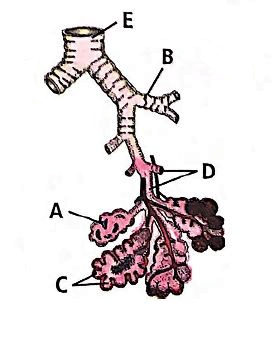
A B C D E (a) Alveolar Secondary bronchus Alveoli Bronchioles Trachea (b) Alveoli Secondary bronchus Alveolar sac Trachea Bronchioles (c) Alveolar sac Tertiary bronchus Alveoli Trachea Bronchioles (d) Alveoli Tertiary bronchus Alveolar sac Bronchioles Trachea
CorrectIncorrectHint
(a) In the given figure depicting the respiratory passage in man, the unidentified parts are as follows: (A) Alveolar sac, (B) Secondary bronchus, (C) Alveoli, (D) Bronchioles, and (E) Trachea.
So, the correct answer is ‘
(A) Alveolar sac (B) Secondary bronchus (C)Alveoli (D) Bronchioles
(E)Trachea’. -
Question 9 of 104
9. Question
Mammalian lungs have an enormous number of minute alveoli (air sacs). This is to allow
CorrectIncorrectHint
(a) The number of alveoli in the human lungs has been estimated to be approximately 300 million. This enormous number of alveoli are meant to increase surface area of lungs for diffusion of gases.
-
Question 10 of 104
10. Question
The given figure shows the diagrammatic view of human respiratory system. Identify A, B, C and D.
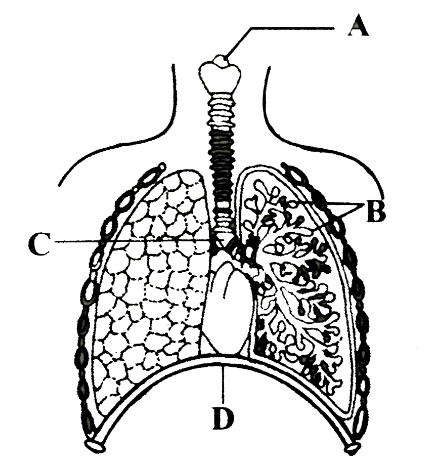 CorrectIncorrect
CorrectIncorrectHint
(a) In the given figure depicting the human respiratory system, the unidentified parts are as follows: A-Epiglottis, B-Alveoli, C-Bronchus, D-Diaphragm. So, the correct answer is ‘ A-Epiglottis, B-Alveoli, C- Bronchus, D-Diaphragm’.
-
Question 11 of 104
11. Question
The given figures are of human larynx, front view (i) and vertical section (ii).
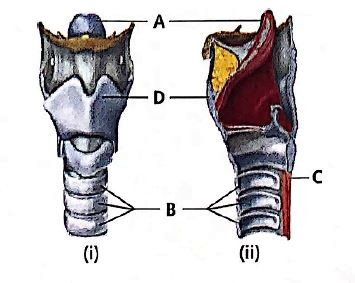
Identify the labelled parts A to D.
A B C D (a) Glottis Larynx Vocal cord Cartilaginous rings of trachea (b) Epiglottis Cartilaginous rings of trachea Trachea Thyroid cartilage (c) Glottis Cartilaginous rings of trachea Larynx Trachea (d) Epiglottis Bony rings of trachea Thyroid cartilage Trachea
CorrectIncorrectHint
(b)
-
Question 12 of 104
12. Question
Lungs are enclosed in
CorrectIncorrectHint
(c) The lungs are covered in a membrane called pleural membrane. The outer covering is called parietal pleura and the inner covering is called visceral pleura.
-
Question 13 of 104
13. Question
Thoracic chamber is formed dorsally by the (i). ventrally by the (iii), laterally by the (iii) and on lower side by the dome shaped (iv).
Select the correct option to complete the above paragraph.(i) (ii) (iii) (iv) (a) vertebral column sternum ribs diaphragm (b) sternum vertebral column diaphragm ribs (c) diaphragm ribs vertebral column sternum (d) ribs diaphragm vertebral column sternum
CorrectIncorrectHint
(a)
-
Question 14 of 104
14. Question
Given below is a list of different steps (i-vi) involved in respiration.
(i) Utilisation of O2 by the cells for catabolic reactions.
(ii) Transport of gases by the blood.
(iii) Pulmonary ventilation by which atmospheric air is drawn in and CO2 is released out.
(iv) Release of resultant CO2.
(v) Diffusion of O2 and CO2 between blood and tissues.
(vi) Diffusion of gases (O2 and CO2) across alveolar tissues.
Select an option which has correct sequence of all the steps.CorrectIncorrectHint
(a) Respiration involves the following steps:
(i) Breathing or pulmonary ventilation by which atmospheric air is drawn in and CO2 rich alveolar air is released out.
(ii) Diffusion of gases (O2 and CO2) across alveolar membrane.
(iii) Transport of gases by the blood.
(iv) Diffusion of O2 and CO2 between blood and tissues.
(v) Utilisation of O2 by the cells for catabolic reactions and resultant release of CO2 (cellular respiration as dealt in the Chapter 12). -
Question 15 of 104
15. Question
Inspiration occurs when there is a negative pressure in the lungs with respect to atmospheric pressure. This negative pressure is achieved when
CorrectIncorrectHint
(a) Because of the pressure gradient between the lungs and the atmosphere, the air moves into and out of the lungs. Inspiration occurs if the pressure within the lungs (intra-pulmonary pressure) is less than the atmospheric pressure i.e. there is a negative pressure in the lungs with respect to atmospheric pressure.
-
Question 16 of 104
16. Question
Read the given statements and select the correct option.
Statement 1: Mammals can eat while breathing.
Statement 2: Mammals have negative pressure breathing.CorrectIncorrectHint
(a) The negative pressure breathing in mammals allows them to eat and breathe at the same time.
-
Question 17 of 104
17. Question
Which of the following parts are involved in the mechanism of breathing?
CorrectIncorrectHint
(d)
-
Question 18 of 104
18. Question
Fill up the blanks in the following paragraph by selecting the correct option.
The movement of air into and out of the lungs is carried out by creating a (i) between the lungs and the atmosphere. Inspiration can occur if intra-pulmonary pressure is (ii) than the atmospheric pressure. Expiration takes place when the intra-pulmonary pressure is (iii) than the atmospheric pressure. Inspiration is initiated by the (iv) of diaphragm which (v) the volume of thoracic chamber in the antero-posterior axis.(i) (ii) (iii) (iv) (v) (a) concentration gradient less higher relaxation increases (b) concentration gradient higher less contraction decreases (c) pressure gradient higher less relaxation decreases (d) pressure gradient less higher contraction increases
CorrectIncorrectHint
(d)
-
Question 19 of 104
19. Question
Which of the following sequences is correct to initiate inspiration?
(i) The contraction of external intercostal muscles raises the ribs and sternum
(ii) Volume of thorax increases in the dorso-ventral axis
(iii) Intrapulmonary pressure decreases
(iv) Diaphragm contraction
(v) Air rushes into lungs
(vi) Volume of thorax increases in the anterior-posterior axisCorrectIncorrectHint
(c) Inspiration can occur if the pressure within the lungs (intra-pulmonary pressure) is less than the atmospheric pressure, i.e., there is a negative pressure in the lungs with respect to atmospheric pressure.
-
Question 20 of 104
20. Question
Which of the following changes occur in diaphragm and intercostal muscles when expiration of air takes place?
CorrectIncorrectHint
(c) When the internal intercostal muscles contract and diaphragm relax, the ribs move downward and inward and diaphragm becomes convex (dome-shaped), thus decreasing the volume of thoracic cavity and increasing the pressure inside as compared to the atmospheric pressure outside. This will cause the air to move out (expiration).
-
Question 21 of 104
21. Question
During expiration, the diaphragm becomes
CorrectIncorrectHint
(a) When the internal intercostal muscles contract and diaphragm relax, the ribs move .downward and inward and diaphragm becomes convex (dome shaped), thus decreasing the volume of thoracic cavity and increasing the pressure inside as compared to the atmospheric pressure outside. This will cause the air to move out (expiration).
-
Question 22 of 104
22. Question
Exhalation is the process of expulsion of air through the respiratory tract. Which figure illustrates the process of exhalation?
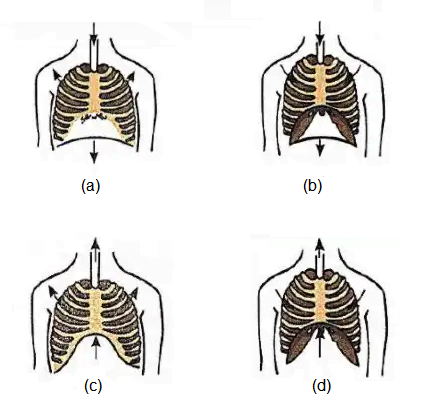 CorrectIncorrect
CorrectIncorrectHint
(d) When the internal intercostal muscles contract and the diaphragm relax, the ribs move downward and inward and the diaphragm becomes convex\domeshaped, thus decreasing the volume of the thoracic cavity and increasing the pressure inside as compared to the atmospheric pressure outside. This will cause the air to move out (expiration).
-
Question 23 of 104
23. Question
The given figure illustrates the changes in lung volume during the process of breathing.
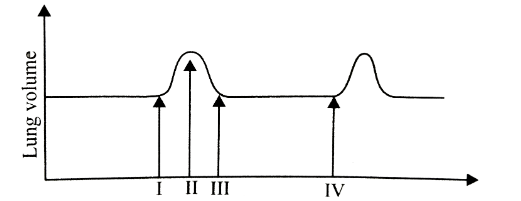
The change from II to III indicates the
CorrectIncorrectHint
(c) The change from II to III indicates decrease in the volume of lungs and thus, increase in the pressure of air inside the lungs. This results in movement of air out of the lungs.
-
Question 24 of 104
24. Question
Which of the following statements about the mechanism of ventilation/breathing is incorrect?
CorrectIncorrectHint
(c) Inspiration is an active process while expiration is a passive process. During inspiration the thoracic cage moves upward and forward to increase the volume of thoracic cavity, this contraction is brought about by the activity of the external intercostals, intercondrial intercostals that elevate the ribs, the diaphragm also achieves a dome shape. Here, the contraction of the muscles to pull the ribs and the diaphragm upwards requires energy. Hence, an active process
During expiration the contracted muscles relax, hence a passive process. So, the correct answer is ‘Inspiration is a passive and expiration is an active process.’
-
Question 25 of 104
25. Question
Select the correct statement.
CorrectIncorrectHint
(a) Expiration takes place when the intra-pulmonary pressure is higher than the atmospheric pressure. The diaphragm and a specialised set of muscles – external and internal intercostals between the ribs, help in generation of such gradients. Inspiration is initiated by the contraction of diaphragm which increases the volume of thoracic chamber in the antero-posterior axis.
-
Question 26 of 104
26. Question
A person breathing normally at rest, takes in and expels approximately half a litre of air during each respiratory cycle. This is called
CorrectIncorrectHint
(b) The volume of air inspired or expired during normal breath is called tidal volume. It is about 500 mL of air in average young adult man.
-
Question 27 of 104
27. Question
Which one of the following statements is incorrect?
CorrectIncorrectHint
(d) In insects, blood (haemolymph) does not contain an oxygen-carrying pigment. Hence it does not help in respiration. Instead, insects have spiracles and tracheae that carry O2 to different tissues.
-
Question 28 of 104
28. Question
Given below are four respiratory capacities and their respiratory volumes.
Respiratory volumes and capacities Volume of air (i) Tidal volume 500 mL (ii) Vital capacity 2500 mL (iii) Functional residual capacity 2300 mL (iv) Total lung capacity 3200 mL
Select the correct matched pair.
CorrectIncorrectHint
(c)
The correct matching of respiratory capacities with their respiratory volumes are: Respiratory Capacities Resiratory Volumes Residual volume 1200 mL Vital capacity 4500 mL Inspiratory reserve volume 2500 mL Inspiratory capacity 3500 mL
-
Question 29 of 104
29. Question
Complete the following sentences by selecting the correct option.
(A) Inspiratory capacity (IC) = (i) + IRV
(B) (ii) =TV+IRV+ERV
(C) Functional residual capacity (FRC) =ERV+ (iii)(i) (ii) (iii) (a) Vital capacity Tidal volume Residual volume (b) Expiratory capacity Residual volume Inspiratory reserve volume (c) Tidal volume Vital capacity Residual volume (d) Tidal volume Total lung capacity Expiratory capacity
CorrectIncorrectHint
(c)
-
Question 30 of 104
30. Question
Consider the following statements each with one or two blanks.
(i) Left lung has (1) lobes and right lung has (2) lobes.
(ii) Prawn respires with (3) and insects with (4).
(iii) Amount of air inhaled and exhaled with maximum effort is referred to as the (5) of the lungs. Fill up the above blanks by selecting the correct option.
Fill up the above blanks by selecting the correct option.CorrectIncorrectHint
(b) Prawn respires with gills (Branchial respiration) and insects respire by tracheae (Tracheal respiration).
-
Question 31 of 104
31. Question
Consider the following statements each with two blanks.
(i) Actually, only about (1) mL of air enters the lung alveoli for the exchange of gases. The remaining fills the respiratory passage and is termed (2).
(ii) The amount of air which one can inhalewith maximum effort and also exhale with maximum effort is termed as (3). It is about (4) in normal adult person.
(iii) During normal quiet breathing, on an average, approximately (5) mL of air is inspired or expired by adult human male in each breath. It is termed as (6) volume.
Which of the following options gives the correct fill-ups for the respective blank numbers from (1) to (6) in the above statements?CorrectIncorrectHint
(a) Actually, only about 350 mL of air (out of total 500 mL tidal volume) enters the lung alveoli for the exchange of gases. The remaining 150 mL fills the respiratory passage and is termed as dead air space because no exchange of gases takes place here.
-
Question 32 of 104
32. Question
The inspiratory capacity includes
CorrectIncorrectHint
(b) Inspiratory Capacity (IC): Total volume of air a person can inspire after a normal expiration. This includes tidal volume and inspiratory
reserve volume ( TV+IRV). -
Question 33 of 104
33. Question
Vital capacity of lungs is
CorrectIncorrectHint
(d) Vital capacity is the maximum volume of air a person can breathe in after a forced expiration or the maximum volume of air a person can breathe out after a forced inspiration. This equals the inspiratory reserve volume (IRV) + expiratory reserve volume (ERV) + tidal volume (TV). Its value is 3400 mL−4800 mL.
-
Question 34 of 104
34. Question
After forceful inspiration, the amount of air that can be breathed out by maximum forced expiration is equal to
CorrectIncorrectHint
(c) Vital capacity is the maximum volume of air a person can breathe in after a forced expiration or the maximum volume of air a person can breathe out after a forced inspiration. This equals the inspiratory reserve volume (IRV) + expiratory reserve volume (ERV) + tidal volume (TV). Its value is 3400 mL−4800 mL.
-
Question 35 of 104
35. Question
Match column I with column II and select the correct option from the given codes.
Column I Column II A. Tidal volume (i) 2500−3000 mL of air B. Inspiratory reserve volume (ii) 1000 mL of air C. Expiratory reserve volume (iii) 500 mL of air D. Residual volume (iv) 3400−4800 mL of air E. Vital capacity (v) 1200 mL of airCorrectIncorrectHint
(b)
-
Question 36 of 104
36. Question
Match column I with column II and select the correct option from the codes given below.
Column I Column II A. TV + ERV (i) Expiratory capacity B. RV + ERV + TV + IRV (ii) Total lung capacity C. ERV + RV (iii) Functional residual capacityCorrectIncorrectHint
(a)
-
Question 37 of 104
37. Question
The exchange of gases in the alveoli of the lungs takes place by
CorrectIncorrectHint
(d) The exchange of gases in the alveoli of the lungs takes place by simple diffusion. The exchange of gases between the alveoli and blood in the lungs is the result of difference in partial pressure of respiratory gases.
-
Question 38 of 104
38. Question
The given figure shows diagrammatic representation of exchange of gases at the alveolus and the body tissues with blood and transport of oxygen and carbon dioxide. Identify the blood vessels A to D.
 CorrectIncorrect
CorrectIncorrectHint
In the given figure depicting the exchange of gases at the alveolus and the body tissues with blood and transport of oxygen and carbon dioxide. The unidentified parts in the given diagram are as follows: A-Systemic vein, B-Pulmonary artery, C- Pulmonary vein, and D- Systemic artery. So, the correct answer is option (a).
-
Question 39 of 104
39. Question
Consider the following statements each with two blanks.
(i) Diaphragm contracts to help in (1) while the contraction of abdominal muscles help in (2).
(ii) Vital capacity of trained athletes is (3) than that of non-athletes while the vital capacity of non-smokers is (4) than that of smokers.
(iii) Alveolar pO2 is (5) than the venous pO2 while arterial pO2 is (6) than the alveolar pO2.
Which of the following options gives the correct fill-ups for the respective blanks numbered from (1) to (6) in the above statements?CorrectIncorrectHint
(c)
-
Question 40 of 104
40. Question
Which of the following would have the same O2 content?
CorrectIncorrectHint
(b) Blood entering the right side of the heart i.e., right atrium is a deoxygenated blood having partial pressure of 40 mm Hg. Blood leaving the right side of the heart i.e., right ventricle will also have almost same partial pressure as the blood is moving from right atrium to right ventricle and also no exchange of gases occurs in this path.
-
Question 41 of 104
41. Question
What is the approximate normal composition of alveolar air?
CorrectIncorrectHint
(a)
-
Question 42 of 104
42. Question
The CO2 content by volume, in the atmospheric air is about
CorrectIncorrectHint
(c)
-
Question 43 of 104
43. Question
Among the following the partial pressure of oxygen is maximum in
CorrectIncorrectHint
(d) The partial pressure of O2 in expired air is 116 mmHg. In alveolar air it is 104 mmHg, in arterial blood it is 95 mmHg and in venous blood it is 40 mmHg.
-
Question 44 of 104
44. Question
In lungs, the air is separated from the venous blood through
CorrectIncorrectHint
(b) The wall of the alveoli is very thin and has a rich network of blood capillaries. The alveolar capillary membrane consists mainly of squamous epithelium, epithelial basement membrane, a thin interstitial space, capillary basement membrane and capillary endothelium.
-
Question 45 of 104
45. Question
The factor which does not affect the rate of alveolar diffusion is
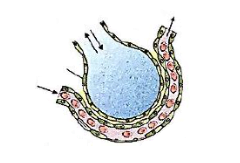 CorrectIncorrect
CorrectIncorrectHint
(d) Solubility of the gases as well as the thickness of the membranes involved in diffusion are also some important factors that can affect the
rate of diffusion. -
Question 46 of 104
46. Question
Which of the following statements is correct?
CorrectIncorrectHint
(c) The thoracic cavity is anatomically an air tight chamber as it consists of lungs that further consist of air sacs in which the air remains trapped. The contraction of the external intercostal muscles lifts up the ribs and sternum. RBCs transport both O2 and CO2. Healthy man can inspire or expire 6000 to 8000 mL of air per minute.
-
Question 47 of 104
47. Question
After taking a long deep breath we do not respire for some seconds due to
CorrectIncorrectHint
(c)
-
Question 48 of 104
48. Question
A large proportion of oxygen remains unused in the human blood even after its uptake by the body tissues. This O2
CorrectIncorrectHint
(a)
-
Question 49 of 104
49. Question
Which of the following is true for CO2 concentration?
CorrectIncorrectHint
(a) Concentration or partial pressure of CO2(pCO2) is 40 mmHg in alveolar air and 32 mmHg in expired air.
-
Question 50 of 104
50. Question
During rest, the metabolic needs of the body are at their minimum. Which of the following is indicative of this situation?
CorrectIncorrectHint
(d) Metabolic activities are the sum of physical and chemical processes taking place in the living organisms. Rate of breathing, O2 intake and CO2 output and pulse rate slow down indicating that the metabolic needs of the body are at their minimum during rest.
-
Question 51 of 104
51. Question
Consider the following four statements ( i – iv) and select the correct option stating which ones are true (T) and which ones are false (F).
(i) Formation of oxyhaemoglobin occurs on alveolar surface.
(ii) During gaseous exchange the gases diffuse from high partial pressure to low partial pressure.
(iii) Carbon dioxide cannot be transported with haemoglobin.
(iv) Earthworm respires through parapodia.(i) (ii) (iii) (iv) (a) T F T F (b) F F T F (c) F T F T (d) T T F F
CorrectIncorrectHint
(d) About 20−25%CO2 is carried by haemoglobin as carbaminohaemoglobin. Earthworm respires through body wall.
-
Question 52 of 104
52. Question
Besides RBC, blood plasma also carries O2 in solution. The percentage is
CorrectIncorrectHint
(d) About 3% of oxygen in blood is dissolved in the plasma which carries oxygen to the body cells.
-
Question 53 of 104
53. Question
Which of the following statements is true about RBCs in humans?
CorrectIncorrectHint
(a) Nearly 20−25% of CO2 is transported by RBCs whereas 70% of it is carried as bicarbonate. About 7% of CO2 is carried in a dissolved state through plasma. About 97% of O2 is carried by RBCs in the blood. About 3% of O2 is transported in a dissolved state through the plasma.
-
Question 54 of 104
54. Question
The carbon dioxide is transported via blood to lungs mostly
CorrectIncorrectHint
(c) Nearly 20−25% of CO2 is transported by RBCs whereas 70% of it is carried as bicarbonate. About 7% of CO2 is carried in a dissolved state through plasma. About 97% of O2 is carried by RBCs in the blood. About 3% of O2 is transported in a dissolved state through the plasma.
-
Question 55 of 104
55. Question
Blood carries the CO2 in three forms. The correct percentages of CO2 in these forms are
As carbamino- haemoglobin in RBC As bicarbonates Dissolved form in plasma (a) 20−25%70%7% (b) 70%20−25%7% (c) 20−25%7%70% (d) 7%20−25%70%
CorrectIncorrectHint
(a) Nearly 20−25% of CO2 is transported by RBCs whereas 70% of it is carried as bicarbonate. About 7% of CO2 is carried in a dissolved state through plasma. About 97% of O2 is carried by RBCs in the blood. About 3% of O2 is transported in a dissolved state through the plasma.
-
Question 56 of 104
56. Question
Bulk of oxygen diffuses from the plasma into the red blood corpuscles where it joins loosely with Fe2+ ions of haemoglobin (Hb) to form bright red oxyhaemoglobin (HbO2). This process is called
CorrectIncorrectHint
(c) The process of addition of oxygen to an atom or a molecule in order to increase the concentration of oxygen in tissue is generally referred to as oxygenation. When the bulk of oxygen diffuses from the plasma into the red blood corpuscles where it joins loosely with Fe2+ ions of haemoglobin (Hb) to form bright red oxyhaemoglobin ( HbO2 ) it is also an example of oxygenation.
So the correct answeris ‘oxvgenation’ -
Question 57 of 104
57. Question
How many molecules of O2 does one haemoglobin carries?
CorrectIncorrectHint
(a) Hb contains a protein portion called globin and a pigment portion called haem. The haem portion consists of four atoms of iron, each capable of combining with a molecule of O2. Thus, one Hb carries 4 molecules of O2.
-
Question 58 of 104
58. Question
The oxygen dissociation curve is
CorrectIncorrectHint
(c) The oxygen dissociation curve is sigmoid curve i.e. S-shaped.
-
Question 59 of 104
59. Question
Which of the following is incorrect about the given graph?
 CorrectIncorrect
CorrectIncorrectHint
(c) The part ‘ B ‘ in the graph represents partial pressure of oxygen.
-
Question 60 of 104
60. Question
The given graph shows an oxygen dissociation curve for haemoglobin.
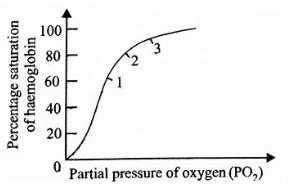
Where in the body will haemoglobin be saturated at the percentages shown at points 1,2 and 3 on the graph?
Left ventricle Pulmonary vein Vena cava (a) 123 (b) 213 (c) 231 (d) 321
CorrectIncorrectHint
(c) The relationship between the partial pressure of O2(pO2) and percentage saturation of the Hb with O2 is graphically illustrated by a curve called oxygen dissociation curve. The haemoglobin is most saturated with oxygen in the pulmonary vein, as this vein is carrying oxygenated blood from the lungs towards the left auricle of the heart. From the left auricle the blood moves to the left ventricle where saturation of Hb with O2 slightly reduces. Vena cava carries deoxygenated blood from all the organs of the body towards right auricle, thus, Hb is less saturated with O2.
-
Question 61 of 104
61. Question
When temperature decreases, oxy-Hb curve becomes
CorrectIncorrectHint
(a) When temperature decreases, oxy-Hb curve will become more steep. The steep rise of the curve indicates high affinity of Hb for O2.
-
Question 62 of 104
62. Question
Which of the following factors is not favourable for the formation of oxyhaemoglobin?
CorrectIncorrectHint
(d) Low pCO2 favours the formation of oxyhaemoglobin.
-
Question 63 of 104
63. Question
63Consider the following four statements and select the correct option stating which ones are true (T) and which ones are false (F).
(i) Expiration is normally brought about by the relaxation of inspiratory muscles.
(ii) Oxyhaemoglobin can hold much less carbon dioxide in the form of carbaminohaemoglobin than what deoxyhaemoglobin can.
(iii) A person can expel all the air from the lungs by a forceful expiration.
(iv) A rise in PCO2 increases the oxygen-affinity of haemoglobin.(i) (ii) (iii) (iv) (a) F F T T (b) T F T T (c) T T F F (d) F F F T
CorrectIncorrectHint
(b) A person cannot expel all the air from the lungs even after forceful expiration. The volume of air which remains in the lungs after the most forceful expiration is called residual volume. It is about 1100 mL to 1200 mL. A rise in pCO2 decreases the O2 affinity of haemoglobin.
-
Question 64 of 104
64. Question
In the tissues, high concentrations of carbon dioxide
CorrectIncorrectHint
(c) : Increase in the CO2 content of the blood decreases the pH of the blood. This decreases the affinity of O2 with Hb. This is called Bohr effect and is closely related to the fact that deoxygenated Hb binds hydrogen ions more actively than does the Hb. This facilitates gaseous exchange because more O2 is released in the tissues where the amount of CO2 is more due to metabolic activity. At the same time, more O2 is taken up by the lungs or gills when the amount of CO2 is low.
-
Question 65 of 104
65. Question
Fetal haemoglobin has X affinity for oxygen than that of mother’s haemoglobin during gestation. X is
CorrectIncorrectHint
(b) Functionally, fetal haemoglobin has a higher affinity to bind with oxygen molecules than the adult (or maternal) haemoglobin, giving the developing fetus better access to oxygen from the mother’s blood stream.
-
Question 66 of 104
66. Question
Read the given statements and select the correct option.
Statement 1: About 70% of CO2 that enters RBCs changes into HCO−3for transport in plasma to the lungs where it reconverts into CO2 for elimination.
Statement 2: About 40% of CO2 that enters RBCs changes into carbaminohaemoglobin which releases O2 in the lungs.CorrectIncorrectHint
(b) About 20−25% of CO2 is carried by Hb as carbaminohaemoglobin. CO2 reacts directly with amine radicals (NH2) of Hb to form an unstable compound called carbaminohaemoglobin which releases CO2 in the lungs.
-
Question 67 of 104
67. Question
Match column I with column II and select the correct option from the codes given below.
Column I Column II A. Tracheoles (i) Yeast B. Carbonic anhydrase (ii) Fish C. Lactic acid (iii) Inspiration D. Fermentation (iv) Vital capacity E. Gill filaments (v) Fast muscle F. Cutaneous respiration (vi) Insect G. Diaphragm (vii) Bicarbonates (viii) Earthworm
CorrectIncorrectHint
(a)
-
Question 68 of 104
68. Question
The enzyme that increases the reaction rate between CO2 and H2O in red blood cells is
CorrectIncorrectHint
(a) About 70% of CO2 is transported in plasma in the form of bicarbonates. CO2 diffuses into RBC, combines with water and forms carbonic acid. Carbonic acid being unstable quickly dissociates into bicarbonate ions and hydrogen ions. This reaction is thousand times faster in RBCs as compared to plasma, as RBCs contain carbonic anhydrase enzyme that reversibly catalyses the conversion of CO2 and water to carbonic acid.
-
Question 69 of 104
69. Question
Which of the following equations is correct?
CorrectIncorrectHint
(b) About 70% of CO2 is transported in plasma in the form of bicarbonates. CO2 diffuses into RBC, combines with water and forms carbonic acid. Carbonic acid being unstable quickly dissociates into bicarbonate ions and hydrogen ions. This reaction is thousand times faster in RBCs as compared to plasma, as RBCs contain carbonic anhydrase enzyme that reversibly catalyses the conversion of CO2 and water to carbonic acid.
-
Question 70 of 104
70. Question
People living at sea level have around 5 million RBC per cubic millimetre of their blood whereas those living at an altitude of 5400 metres have around 8 million. This is because at high altitude
CorrectIncorrectHint
(c) Number of RBCs per cubic millimetre of blood is likely to be higher in people living at high altitudes. This is in response to the air being less dense at high altitude and thus more RBCs (and hence more Hb ) are needed to absorb the required amount of O2 from the air having low PO2.
-
Question 71 of 104
71. Question
Identify the correct statement with reference to transport of respiratory gases by blood.
CorrectIncorrectHint
(b)
-
Question 72 of 104
72. Question
In humans, which of the following is not a step in respiration?
CorrectIncorrectHint
(d) Respiration involves the following steps:
(i) Breathing or pulmonary ventilation by which atmospheric air is drawn in and CO2 rich alveolar air is released out.
(ii) Diffusion of gases (O2 and CO2) across alveolar membrane.
(iii) Transport of gases by the blood.
(iv) Diffusion of O2 and CO2 between blood and tissues.
(v) Utilisation of O2 by the cells for catabolic reactions and resultant release of CO2 (cellular respiration as dealt in the Chapter 12). -
Question 73 of 104
73. Question
Although much CO2 is carried in blood, yet blood does not become acidic, because
CorrectIncorrectHint
(c) Although much CO2 is carried in the blood, yet blood does not become acidic. It is due to CO2 transport and buffering action of blood. The main buffer present in the blood is bicarbonate (which is formed during CO2 transport in the blood). Bicarbonates exist in equilibrium with carbonic acid which in turn can be converted to CO2 and water.
H2O+CO2⇌H2CO3⇌H++HCO−3
-
Question 74 of 104
74. Question
Which one of the following can bind several hundred times more strongly to the haemoglobin than oxygen?
CorrectIncorrectHint
(c)
-
Question 75 of 104
75. Question
Select the correct statement.
CorrectIncorrectHint
(b) CO2 is carried by haemoglobin as carbamino-haemoglobin (about 20-25 per cent). This binding is related to the partial pressure of CO2. pO2 is a major factor which could affect this binding. When pCO2 is high and pO2 is low as in the tissues, more binding of carbon dioxide occurs whereas, when the pCO2 is low and pO2 is high as in the alveoli, dissociation of CO2 from carbamino-haemoglobin takes place, i.e., CO2 which is bound to haemoglobin from the tissues is delivered at the alveoli.
-
Question 76 of 104
76. Question
Match column I with column II and select the correct option from the given codes.
Column I Column II A. Trachea (i) pO2 in alveolar air B. Respiratory centre (ii) ATP C. Yeast (iii) Cartilaginous rings D. Pigeon (iv) Medulla oblongata E. Fish (v) Larynx F. Biologically useful energy (vi) Lungs G. 100 mmHg (vii) Ethanol H. Vocal cords (viii) Branchial respiration
CorrectIncorrectHint
(a)
-
Question 77 of 104
77. Question
Pneumotaxic centre which can moderate the functions of the respiratory rhythm centre is present in
CorrectIncorrectHint
(a) Pneumotaxic centre is present in the dorsal part of the pons varolii of the brain. Its function is primarily to limit inspiration.
-
Question 78 of 104
78. Question
Match column I with column II and select the correct option from the codes given below.
Column I Column II A. Carbamino- haemoglobin (i) Inspiration B. Diaphragm (ii) Hamburger’s phenomenon C. Larynx (iii) Diffusion of Cl−into RBCs D. Pons varolii (iv) Carbon dioxide E. Chloride shift (v) Cartilages (vi) Pneumotaxic centre (vii) Expiration
CorrectIncorrectHint
(a)
-
Question 79 of 104
79. Question
Chemosensitive area of respiratory centre in medulla is affected by
CorrectIncorrectHint
(c) A chemosensitive area situated adjacent to the rhythm centre of the medulla is highly sensitive to changes in CO2 and hydrogen ion concentrations in blood. Increase in CO2 and H+ions stimulate this centre, which in turn stimulate the rhythm centre to make necessary adjustments in the respiratory process by which these substances can be eliminated.
-
Question 80 of 104
80. Question
Fill up the blanks in the following paragraph by selecting the correct option.
Human beings have a significant ability to maintain and moderate the respiratory rhythm to suit the demands of the body tissues. This is done by the neural system. A specialised centre present in the medulla region of the brain called (i) is primarily responsible for this regulation. Another centre present in the pons region of the brain called (ii) can moderate the functions of the respiratory rhythm centre. Neural signal from this centre can reduce the duration of (iii) and thereby alter the respiratory rate. A (iv) is situated adjacent to the rhythm centre which is highly sensitive to CO2 and hydrogen ions.(i) (ii) (iii) (iv) (a) Chemosensitive area Respiratory rhythm centre Expiration Pneumotaxic centre (b) Respiratory rhythm centre Pneumotaxic Centre Inspiration Chemosensitive area (c) Respiratory rhythm centre Chemosensitive area Expiration Pneumotaxic centre (d) Pneumotaxic centre Chemosensitive area Inspiration Respiratory rhythm centre
CorrectIncorrectHint
(b)
-
Question 81 of 104
81. Question
Rate of breathing is controlled mainly by
CorrectIncorrectHint
(a) Rate of breathing is mainly controlled by CO2 level in the blood. Excess CO2 mainly stimulate the respiratory centre of the brain and increase the inspiratory and expiratory signals to the respiratory muscles.
-
Question 82 of 104
82. Question
The respiratory centre in the brain is stimulated by
CorrectIncorrectHint
(c) Rate of breathing is mainly controlled by CO2 level in the blood. Excess CO2 mainly stimulate the respiratory centre of the brain and increase the inspiratory and expiratory signals to the respiratory muscles.
-
Question 83 of 104
83. Question
Complete the following sentence by selecting the correct option.
Receptors associated with the aortic arch and carotid artery can recognise changes in (i) and (ii) concentration and send necessary signals to (iii) for remedial actions.(i) (ii) (iii) (a) O2CO2 pneumotaxic centre (b) CO2H+rhythm centre (c) CO2H+apneustic centre (d) O2H+pneumotaxic centre
CorrectIncorrectHint
(b) Receptors associated with aortic arch and carotid artery can recognise change in CO2 and H+concentration and send necessary signals to rhythm centre for remedial actions.
-
Question 84 of 104
84. Question
Complete the following sentence by selecting the correct option.
The breathing rhythm is generated in the (i) and is influenced by variation in levels of (ii) in the blood.(i) (ii) (a) medulla CO2 (b) medulla O2 (c) frontal lobe CO2 and O2 (d) frontal lobe CO2
CorrectIncorrectHint
(a) The basic rhythm of respiration is generated mainly in the dorsal respiratory group in the medulla. Changes in blood carbon dioxide is believed to stimulate the neurons in chemosensitive area which affect the rhythm centre. CO2 acts by forming carbonic acid which dissociates into H+and HCO−3. H+has direct effect on this. Oxygen does not have a significant direct effect on rhythm centre.
-
Question 85 of 104
85. Question
When CO2 concentration in blood increases breathing becomes
CorrectIncorrectHint
(d) When CO2 concentration in blood increases, breathing becomes faster and deeper. The effect of rising CO2 concentration is due to decrease in affinity of Hb for O2. Thus, the CO2 released in the tissues accelerates the delivery of O2 (called Bohr effect), due to which breathing becomes faster and deeper.
-
Question 86 of 104
86. Question
Read the given statements and select the correct option.
Statement 1: Rate of breathing is regulated by respiratory centres present in the medulla oblongata.
Statement 2: Changes in the CO2 level of the arterial blood control the rate of breathing.CorrectIncorrectHint
(a) Rate of breathing is mainly controlled by CO2 level in the blood. Excess CO2 mainly stimulate the respiratory centre of the brain and increase the inspiratory and expiratory signals to the respiratory muscles.
-
Question 87 of 104
87. Question
Read the following four statements (i) – (iv) with certain mistakes in two of them.
(i) A water breather expends much more energy in ventilating its respiratory surface than an airbreathing one.
(ii) Lungs become empty after forceful expiration.
(iii) The exchange of gases in the lungs is interrupted during expiration.
(iv) Respiratory movements are controlled by CO2 concentration of arterial blood.
Which of the above two statements have mistakes?CorrectIncorrectHint
(b) Expiration takes place when the intra-pulmonary pressure is higher than the atmospheric pressure. The diaphragm and a specialised set of muscles – external and internal intercostals between the ribs, help in generation of such gradients. Inspiration is initiated by the contraction of diaphragm which increases the volume of thoracic chamber in the antero-posterior axis.
-
Question 88 of 104
88. Question
The urge to inhale in humans results from
CorrectIncorrectHint
(a) Rate of breathing is mainly controlled by CO2 level in the blood. Excess CO2 mainly stimulate the respiratory centre of the brain and increase the inspiratory and expiratory signals to the respiratory muscles.
-
Question 89 of 104
89. Question
Read the following four statements carefully.
(i) Ventral respiratory group of neurons of medulla oblongata can cause both inspiration and expiration.
(ii) The part of the respiratory system starting with the external nostrils up to the terminal bronchioles constitutes the respiratory or exchange part of the respiratory system.
(iii) During swallowing epiglottis can be covered by a thin elastic cartilaginous flap called glottis to prevent the entry of food into the larynx.
(iv) Binding of oxygen with haemoglobin is primarily related to partial pressure of O2.
Which of the above two statements are correct?CorrectIncorrectHint
(d) The part of the respiratory system starting with the external nostrils up to the terminal bronchioles constitutes the conducting part whereas the alveoli and their ducts form the respiratory or exchange part. During swallowing, glottis can be covered by a thin elastic cartilaginous flap called epiglottis to prevent the entry of food into the larynx.
-
Question 90 of 104
90. Question
Emphysema is a condition resulting from
CorrectIncorrectHint
(a) Emphysema is a respiratory disorder which causes the inflation or abnormal distension of the bronchioles or alveolar sacs resulting in the loss of their elasticity. It is caused by cigarette smoking and chronic bronchitis.
-
Question 91 of 104
91. Question
Which one of the following is the incorrect statement for respiration in humans?
CorrectIncorrectHint
(d) Most of the Carbon dioxide is carried in the form of bicarbonate ions. Grinding or stone breaking industries produce so much dust that long exposure to this can give rise to inflammation of lungs leading to fibrosis (proliferation of fibrous tissues) and thus causing serious lung damage. Inflammation of the bronchi may also be caused by cigarette smoking. The primary function of pneumotaxic centre is to limit inspiration which increases breathing rate.
-
Question 92 of 104
92. Question
Name the pulmonary disease in which alveolar surface area involved in gas exchange is drastically reduced due to damage in the alveolar walls.
CorrectIncorrectHint
94. (d) : Emphysema is an inflation or abnormal distension of the bronchioles or alveolar sacs of the lungs. Many of the septa between the alveoli are destroyed and much of the elastic tissue of the lungs is replaced by connective tissue. As the alveolar septa collapse, the surface area for gas exchange is greatly reduced. There is a loss of elasticity in the walls of bronchioles or alveolar sacs. As a result, the alveolar sacs remain filled with air even after expiration. The exhalation becomes more difficult. The lungs remain inflated. Major causes of emphysema are cigarette smoking and the inhalation of smoke or other toxic substances over a period of time.
-
Question 93 of 104
93. Question
Visiting high mountains may cause altitude sickness in men living in plain areas. Prime cause of this is
CorrectIncorrectHint
(c) The effects of high altitude on humans are considerable. The percentage oxygen saturation of haemoglobin determines the content of oxygen in the blood. When a person living in the plain area visit high mountains up to around 2,100 m ( 7,000 feet) above sea level, the saturation of oxyhaemoglobin begins to decrease rapidly in the blood and can cause hypoxia. So, the correct answer is “Decreased partial pressure of oxygen”.
-
Question 94 of 104
94. Question
Carbon monoxide can kill a person because of it’s extremely high affinity for
CorrectIncorrectHint
(a) Carbon monoxide combines with Hb far more readily than O2 ( CO has about 200 times greater affinity for Hb as compared to O2 ), forming a relatively stable compound carboxyhaemoglobin. This causes low supply of O2 to the body cells leading to headache, nausea, dizziness, paralysis and even death.
-
Question 95 of 104
95. Question
Asthma may be attributed to
CorrectIncorrectHint
(d) Asthma is an allergic condition in which the tissue surrounding the bronchioles of the lungs swell up and compress the bronchioles thus causing difficulty in breathing. This allergy mainly involves IgE antibodies and chemicals like histamine and serotonin from the mast cells.
-
Question 96 of 104
96. Question
Blood analysis of a patient reveals an unusually high quantity of carboxyhaemoglobin content. Which of the following conclusions is most likely to be correct?
The patient has been inhaling polluted air containing unusually high content ofCorrectIncorrectHint
(c) Carbon monoxide combines with Hb far more readily than O2 ( CO has about 200 times greater affinity for Hb as compared to O2 ), forming a relatively stable compound carboxyhaemoglobin. This causes low supply of O2 to the body cells leading to headache, nausea, dizziness, paralysis and even death.
-
Question 97 of 104
97. Question
During winter a person died during sleep, the room was closed and a container with burnt charcoal was found in the room. What may be the possible reason of his death?
CorrectIncorrectHint
(b) Charcoal on burning produces carbon monoxide (CO). CO has about 200 times more affinity for Hb than O2. On combining with Hb, it forms a stable compound carboxyhaemoglobin. Because of this compound, Hb cannot carry sufficient O2 to the tissues ultimately leading to death.
-
Question 98 of 104
98. Question
Refer to the given graph and select the correct options for the questions that follow.
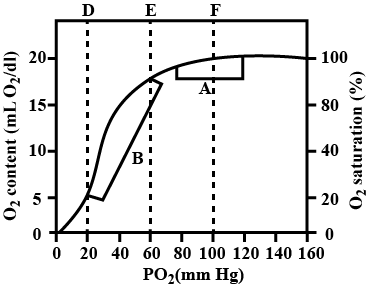
Blood can combine with almost ____ of oxygen if the haemoglobin is 100 percent saturated.
CorrectIncorrectHint
(c)
-
Question 99 of 104
99. Question
Refer to the given graph and select the correct options for the questions that follow.

Which of these is incorrect regarding A and B in the given graph?
CorrectIncorrectHint
(a)
-
Question 100 of 104
100. Question
Refer to the given graph and select the correct options for the questions that follow.
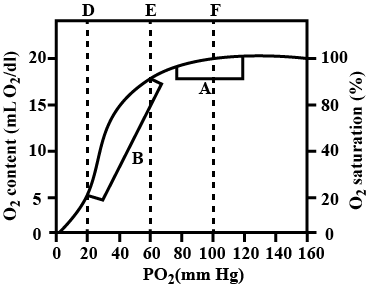
Which of these is correct regarding D, E and F areas in the graph?
CorrectIncorrectHint
(d) D – Venous blood during exercise
E – Normal venous blood
F – Normal arterial blood -
Question 101 of 104
101. Question
Refer to the given graph and select the correct options for the questions that follow.
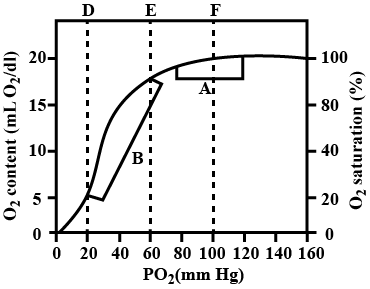
How much oxygen will be released to the tissues by blood on passing from lungs to tissues?
CorrectIncorrectHint
(c) 5 mL of O2/100 mL of blood is released to tissues by blood as it passes from lungs to tissues.
-
Question 102 of 104
102. Question
Refer to the given graph and select the correct options for the questions that follow.

During strenuous exercise, the muscle interstitial fluid pO2 falls to 20 mmHg. The oxygen delivered by blood that passes through the exercising muscle tissues will be
CorrectIncorrectHint
(c) The given graph shows the relationship between partial pressure of oxygen with the amount of oxygen that can bind with haemoglobin. The pO2 of the air within alveoli is about 100 mm Hg. As the blood travels through the systemic blood capillaries, oxygen leaves the blood and diffuses into the tissues. Consequently, the blood that leaves the tissues in the veins has a pO2 that is decreasing (in a resting person) to about 40 mmHg. Therefore, A depicts oxygenated blood and B depicts systemic blood.
The steep portion of the curve from 60 down to 20 mmHg is ideal for unloading oxygen in the tissue, i.e., for a small decrease in pO2 (due to diffusion of oxygen) a large quantity of oxygen can be unloaded to the peripheral tissue capillary. During strenuous exercise, the muscles accelerated metabolism uses more oxygen from the capillary blood and thus decreases the venous blood pO2 – for example the pO2 of the venous blood could drop to 20 mm Hg. Hence, D,E and F shows venous blood in exercise, normal venous blood and normal arterial blood respectively.
As we know, in the resting person, the pO2 of tissues is 40 mmHg, which is favourable for oxygen diffusion from arterial blood to the tissues. Oxygen unloaded to the tissues by arterial blood is 5 mL/100 mL of blood (20 mL−15 mL=5 mL/100 mL, from the graph). During strenuous exercise, the muscle interstitial fluid pO2 falls to 20 mmHg, so the oxygen that unload to the tissue is 15 mL/100 mL of blood, (20−5)mL/100 mL=15 mL/100 mL, from the graph i.e., three times as much as normal. -
Question 103 of 104
103. Question
Refer to the given figure and select the correct options for the questions that follow.
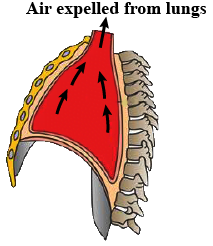
Which of these is incorrect regarding the given mechanism of breathing?
CorrectIncorrectHint
During expel of air from lungs the volume of thorax decreases as it recoils and the diaphragm pushes as it relaxes. The ribs and sternum are relaxed and arch downwards pushing the air out. So the correct answer is ” Ribs and sternum are raised”.
-
Question 104 of 104
104. Question
Refer to the given figure and select the correct options for the questions that follow.

In the given mechanism, diaphragm, sternum and intercostal muscles work together to ____ the thoracic volume and thereby pulmonary volume. This leads to ____ intra-pulmonary pressure to slightly ____ the atmospheric pressure, causing expiration. Select the correct sequence of words to complete the above paragraph.
CorrectIncorrectHint
(c) During inspiration, the contraction of external intercostal muscles lifts up the ribs and the sternum to increase thoracic volume. The given diagram shows expiration process. The relaxing diaphragm and intercostal muscles return to their normal positions which reduce the thoracic volume and thereby the pulmonary volume. This leads to an increase in intra-pulmonary pressure to slightly above the atmospheric pressure causing the expulsion of air from the lungs, i.e., expiration.